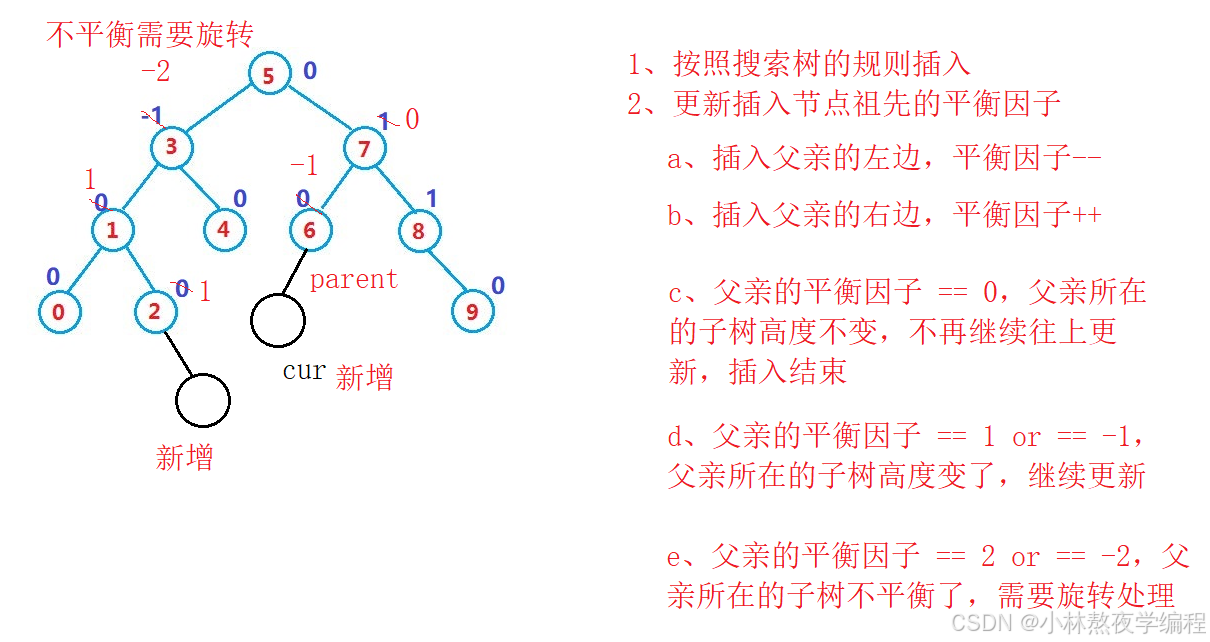✨个人主页: 熬夜学编程的小林
?系列专栏: 【C语言详解】 【数据结构详解】【C++详解】
目录
1 AVL 树
1.1 AVL树的概念
1.2 AVL树节点的定义
1.3 AVL树的插入
1.4 AVL树的旋转
1.5 AVL树的验证
1 AVL 树
1.1 AVL树的概念
二叉搜索树虽可以缩短查找的效率,但如果数据有序或接近有序二叉搜索树将退化为单支树,查
找元素相当于在顺序表中搜索元素,效率低下。因此,两位俄罗斯的数学家G.M.Adelson-Velskii
和E.M.Landis在1962年发明了一种解决上述问题的方法:当向二叉搜索树中插入新结点后,如果能保证每个结点的左右子树高度之差的绝对值不超过1(需要对树中的结点进行调整),即可降低树的高度,从而减少平均搜索长度。
为什么保证每个结点的左右子树高度之差的绝对值不超过1,而不是高度差为0?
有些结点情况下,比如2/4,做不到平衡,因此退而求其次,左右的高度差不超过1。

一棵AVL树或者是空树,或者是具有以下性质的二叉搜索树:

如果一棵二叉搜索树是高度平衡的,它就是AVL树。如果它有n个结点,其高度可保持在
O(log2 n),搜索时间复杂度O(log2 n)。
1.2 AVL树节点的定义
AVL树的节点定义的成员变量:
存储值:每个节点存储的值。左节点指针:指向当前节点的左节点的指针。右节点指针:指向当前节点的右节点的指针。双亲节点指针:指向当前节点的双亲节点的指针。根节点的双亲节点指针为空。平衡因子:表示当前节点的右子树高度和左子树高度之差。平衡因子可以为-1、0或1。
AVL树节点的定义:
template<class K,class V>struct AVLTreeNode{AVLTreeNode<K, V>* _left;// 左孩子AVLTreeNode<K, V>* _right;// 右孩子AVLTreeNode<K, V>* _parent;// 双亲pair<K, V> _kv;int _bf;// balance factor 平衡因子AVLTreeNode(const pair<K,V>& kv):_left(nullptr),_right(nullptr),_parent(nullptr),_kv(kv),_bf(0){}};AVL树基本结构的定义:
template<class K,class V>class AVLTree{ // 重命名结点typedef AVLTreeNode<K, V> Node;public: // 插入bool Insert(const pair<K,V>& kv); // 判平衡bool IsBalance() // 求高度int Height() // 求结点个数int Size() // 查找Node* Find(const K& key) // 中序遍历void InOrder()private: // 结点成员Node* _root = nullptr;};
1.3 AVL树的插入
AVL树就是在二叉搜索树的基础上引入了平衡因子,因此AVL树也可以看成是二叉搜索树。那么
AVL树的插入过程可以分为两步:
按照搜索树规则插入节点
bool Insert(const pair<K,V>& kv){ // 1. 先按照二叉搜索树的规则将节点插入到AVL树中if (_root == nullptr){_root = new Node(kv);return true;}Node* parent = nullptr;Node* cur = _root;while (cur){// 插入值更大则插入到右边// .优先级高于->if (cur->_kv.first < kv.first){parent = cur;cur = cur->_right;}// 小则在左边else if (cur->_kv.first > kv.first){parent = cur;cur = cur->_left;}// 二叉搜索树默认不能冗余,因此相等则返回falseelse{return false;}}// 为空则找到插入位置 需要先找到父亲的位置// key值大于父亲的值则在右侧cur = new Node(kv);if (parent->_kv.first < kv.first){parent->_right = cur;}else{parent->_left = cur;} // 链接双亲结点,搜索二叉树没有双亲结点cur->_parent = parent; //...}更新插入节点的平衡因子
cur插入后,parent的平衡因子一定需要调整,在插入之前,parent的平衡因子分为三种情况:-1,0, 1, 分以下两种情况:
1. 如果cur插入到pParent的左侧,只需给parent的平衡因子-1即可 2. 如果cur插入到pParent的右侧,只需给parent的平衡因子+1即可
此时:parent的平衡因子可能有三种情况:0,正负1, 正负2

bool Insert(const pair<K,V>& kv){ // 2. 新节点插入后,AVL树的平衡性可能会遭到破坏,此时就需要更新平衡因子,并检测是否破坏了AVL树的平衡性// 更新平衡因子while (parent)// 最坏情况为空结束循环{// 插入父亲的左边,父亲的平衡因子--if (cur == parent->_left){parent->_bf--;}// 插入父亲的右边,父亲的平衡因子++else{parent->_bf++;}// 判断父亲的平衡因子的情况// 平衡因子为0,树高度没变,不再更新if (parent->_bf == 0){break;}// 父亲的子树高度变了,需要继续更新平衡因子else if (parent->_bf == 1 || parent->_bf == -1){cur = parent;parent = parent->_parent;}// 父亲所在的子树高度不平衡,需要旋转处理else if (parent->_bf == 2 || parent->_bf == -2){// 旋转}// 理论上不可能出现该情况else{assert(false);}}return true;}1.4 AVL树的旋转
如果在一棵原本是平衡的AVL树中插入一个新节点,可能造成不平衡,此时必须调整树的结构,
使之平衡化。根据节点插入位置的不同,AVL树的旋转分为四种:
1. 新节点插入较高左子树的左侧---左左:右单旋
抽象图

具象图

上图在插入前,AVL树是平衡的,新节点插入到30的左子树(注意:此处不是左孩子)中,30左子树增加了一层,导致以60为根的二叉树不平衡,要让60平衡,只能将60左子树的高度减少一层,右子树增加一层,即将左子树往上提,这样60转下来,因为60比30大,只能将其放在30的右子树,而如果30有右子树,右子树根的值一定大于30,小于60,只能将其放在60的左子树,旋转完成后,更新节点的平衡因子即可。在旋转过程中,有以下几种情况需要虑:
1. 30节点的右孩子可能存在,也可能不存在
2. 60可能是根节点,也可能是子树
如果是根节点,旋转完成后,要更新根节点 如果是子树,可能是某个节点的左子树,也可能是右子树代码
// 右单旋 左边较高void RotateR(Node* parent){Node* subL = parent->_left;Node* subLR = subL->_right;// 更新parentparent->_left = subLR;// subLR不为空则更新父亲,subLR为30的右孩子if (subLR)subLR->_parent = parent;subL->_right = parent;//xxx// 提前存parent的父亲Node* ppNode = parent->_parent;parent->_parent = subL;// parent为根节点if (parent == _root){_root = subL;_root->_parent = nullptr;}else{// parent为ppNode的左结点if (parent == ppNode->_left){ppNode->_left = subL;}else{ppNode->_right = subL;}subL->_parent = ppNode;}// 更新平衡因子subL->_bf = parent->_bf = 0;}
2. 新节点插入较高右子树的右侧---右右:左单旋

1. 60节点的左孩子可能存在,也可能不存在
2. 30可能是根节点,也可能是子树
如果是根节点,旋转完成后,要更新根节点 如果是子树,可能是某个节点的左子树,也可能是右子树代码
// 左单旋 右边较高void RotateL(Node* parent){Node* subR = parent->_right;Node* subRL = subR->_left;// 更新parentparent->_right = subRL;// subRL不为空,subRL为60的左孩子if (subRL)subRL->_parent = parent;subR->_left = parent;// 提前存parent的父结点Node* ppNode = parent->_parent;parent->_parent = subR;// parent为根节点if (parent == _root){_root = subR;_root->_parent = nullptr;}else{// 左if (parent == ppNode->_right){ppNode->_right = subR;}else{ppNode->_left = subR;}subR->_parent = ppNode;}// 平衡因子subR->_bf = parent->_bf = 0;}
3. 新节点插入较高左子树的右侧---左右:先左单旋再右单旋
抽象图
在 b 子树中插入

在 c 子树中插入

具象图

将双旋变成单旋后再旋转,即:先对30进行左单旋,然后再对90进行右单旋,旋转完成后再
考虑平衡因子的更新。
// 左右单旋void RotateLR(Node* parent){Node* subL = parent->_left;Node* subLR = subL->_right;int bf = subLR->_bf;// 先对左孩子左单旋RotateL(parent->_left);// 再对parent右单旋RotateR(parent);if (bf == -1){subLR->_bf = 0;subL->_bf = 0;parent->_bf = 1;}else if (bf == 1){subLR->_bf = 0;parent->_bf = 0;subL->_bf = -1;}else if (bf == 0){subLR->_bf = 0;parent->_bf = 0;subL->_bf = 0;}else{assert(false);}}
4. 新节点插入较高右子树的左侧---右左:先右单旋再左单旋
抽象图
在c 子树中插入

在 b 子树中插入

具象图

将双旋变成单旋后再旋转,即:先对90进行右单旋,然后再对30进行左单旋,旋转完成后再
考虑平衡因子的更新。
void RotateRL(Node* parent){Node* subR = parent->_right;Node* subRL = subR->_left;int bf = subRL->_bf;//决定最终平衡因子的情况// 先对右孩子右单旋RotateR(parent->_right);// 再对自己左单旋RotateL(parent);if (bf == 1){subRL->_bf = 0;subR->_bf = 0;parent->_bf = -1;}else if (bf == -1){subRL->_bf = 0;subR->_bf = 1;parent->_bf = 0;}else if (bf == 0){subRL->_bf = 0;subR->_bf = 0;parent->_bf = 0;}else{assert(false);}}注意:双旋之后需要调节根据情况调节平衡因子,单旋之后平衡因子都为0。
总结:
假如以parent为根的子树不平衡,即parent的平衡因子为2或者-2,分以下情况考虑
1. parent的平衡因子为2,说明parent的右子树高,设parent的右子树的根为SubR
2. parent的平衡因子为-2,说明parent的左子树高,设parent的左子树的根为SubL
当SubL的平衡因子为-1是,执行右单旋当SubL的平衡因子为1时,执行左右双旋旋转完成后,原parent为根的子树个高度降低,已经平衡,不需要再向上更新。
1.5 AVL树的验证
AVL树是在二叉搜索树的基础上加入了平衡性的限制,因此要验证AVL树,可以分两步:
1. 验证其为二叉搜索树
2. 验证其为平衡树
每个节点子树高度差的绝对值不超过1(注意节点中如果没有平衡因子)节点的平衡因子是否计算正确高度计算
int _Height(Node* root){if (root == nullptr)return 0;// 左右子树较高树的高度+1return max(_Height(root->_left), _Height(root->_right)) + 1;}判断平衡
1.空树则满足平衡搜索二叉树
2.判断当前结点高度差的绝对值是否小于等于1
3.检查平衡因子是否正确
4.继续判断左子树与右子树
bool _IsBalance(Node* root){if (root == nullptr)return true;int leftHeight = _Height(root->_left);int rightHeight = _Height(root->_right);// 不平衡能直接返回结果if (abs(leftHeight - rightHeight) >= 2)return false;// 顺便检查一下平衡因子是否正确if (rightHeight - leftHeight != root->_bf){cout << root->_kv.first << endl;return false;}return _IsBalance(root->_left)&& _IsBalance(root->_right);}1.7 AVL树的性能
AVL树是一棵绝对平衡的二叉搜索树,其要求每个节点的左右子树高度差的绝对值都不超过1,这样可以保证查询时高效的时间复杂度,即log2 N。但是如果要对AVL树做一些结构修改的操作,性能非常低下,比如:插入时要维护其绝对平衡,旋转的次数比较多,更差的是在删除时,有可能一直要让旋转持续到根的位置。因此:如果需要一种查询高效且有序的数据结构,而且数据的个数为静态的(即不会改变),可以考虑AVL树,但一个结构经常修改,就不太适合。
1.8 AVL树完整代码
template<class K,class V>struct AVLTreeNode{AVLTreeNode<K, V>* _left;AVLTreeNode<K, V>* _right;AVLTreeNode<K, V>* _parent;pair<K, V> _kv;int _bf;// balance factorAVLTreeNode(const pair<K,V>& kv):_left(nullptr),_right(nullptr),_parent(nullptr),_kv(kv),_bf(0){}};template<class K,class V>class AVLTree{typedef AVLTreeNode<K, V> Node;public:bool Insert(const pair<K,V>& kv){if (_root == nullptr){_root = new Node(kv);return true;}Node* parent = nullptr;Node* cur = _root;while (cur){// 插入值更大则插入到右边// .优先级高于->if (cur->_kv.first < kv.first){parent = cur;cur = cur->_right;}// 小则在左边else if (cur->_kv.first > kv.first){parent = cur;cur = cur->_left;}// 二叉搜索树默认不能冗余,因此相等则返回falseelse{return false;}}// 为空则找到插入位置 需要先找到父亲的位置// key值大于父亲的值则在右侧cur = new Node(kv);if (parent->_kv.first < kv.first){parent->_right = cur;}else{parent->_left = cur;}cur->_parent = parent;// 更新平衡因子while (parent)// 最坏情况为空结束循环{// 插入父亲的左边,父亲的平衡因子--if (cur == parent->_left){parent->_bf--;}// 插入父亲的右边,父亲的平衡因子++else{parent->_bf++;}// 判断父亲的平衡因子的情况// 平衡因子为0,树高度没变,不再更新if (parent->_bf == 0){break;}// 父亲的子树高度变了,需要继续更新平衡因子else if (parent->_bf == 1 || parent->_bf == -1){cur = parent;parent = parent->_parent;}// 父亲所在的子树高度不平衡,需要旋转处理else if (parent->_bf == 2 || parent->_bf == -2){// 右单旋if (parent->_bf == -2 && cur->_bf == -1){RotateR(parent);}// 左单旋else if (parent->_bf == 2 && cur->_bf == 1){RotateL(parent);}// 右左单旋 右高 左高else if (parent->_bf == 2 && cur->_bf == -1){RotateRL(parent);}// 左右单旋 左高 右高else if (parent->_bf == -2 && cur->_bf == 1){RotateLR(parent);}break;// 跳出循环,旋转之后一定平衡}// 理论上不可能出现该情况else{assert(false);}}return true;}// 右单旋 左边较高void RotateR(Node* parent){Node* subL = parent->_left;Node* subLR = subL->_right;// 更新parentparent->_left = subLR;// subLR不为空则更新父亲if (subLR)subLR->_parent = parent;subL->_right = parent;//xxx// 提前存parent的父亲Node* ppNode = parent->_parent;parent->_parent = subL;// parent为根节点if (parent == _root){_root = subL;_root->_parent = nullptr;}else{// parent为ppNode的左结点if (parent == ppNode->_left){ppNode->_left = subL;}else{ppNode->_right = subL;}subL->_parent = ppNode;}// 更新平衡因子subL->_bf = parent->_bf = 0;}// 左单旋 右边较高void RotateL(Node* parent){Node* subR = parent->_right;Node* subRL = subR->_left;// 更新parentparent->_right = subRL;// subRL不为空if (subRL)subRL->_parent = parent;subR->_left = parent;// 提前存parent的父结点Node* ppNode = parent->_parent;parent->_parent = subR;// parent为根节点if (parent == _root){_root = subR;_root->_parent = nullptr;}else{// 左if (parent == ppNode->_right){ppNode->_right = subR;}else{ppNode->_left = subR;}subR->_parent = ppNode;}// 平衡因子subR->_bf = parent->_bf = 0;}void RotateRL(Node* parent){Node* subR = parent->_right;Node* subRL = subR->_left;int bf = subRL->_bf;//决定最终平衡因子的情况// 先对右孩子右单旋RotateR(parent->_right);// 再对自己左单旋RotateL(parent);if (bf == 1){subRL->_bf = 0;subR->_bf = 0;parent->_bf = -1;}else if (bf == -1){subRL->_bf = 0;subR->_bf = 1;parent->_bf = 0;}else if (bf == 0){subRL->_bf = 0;subR->_bf = 0;parent->_bf = 0;}else{assert(false);}}// 左右单旋void RotateLR(Node* parent){Node* subL = parent->_left;Node* subLR = subL->_right;int bf = subLR->_bf;// 先对左孩子左单旋RotateL(parent->_left);// 再对parent右单旋RotateR(parent);if (bf == -1){subLR->_bf = 0;subL->_bf = 0;parent->_bf = 1;}else if (bf == 1){subLR->_bf = 0;parent->_bf = 0;subL->_bf = -1;}else if (bf == 0){subLR->_bf = 0;parent->_bf = 0;subL->_bf = 0;}else{assert(false);}}bool IsBalance(){return _IsBalance(_root);}int Height(){return _Height(_root);}int Size(){return _Size(_root);}Node* Find(const K& key){Node* cur = _root;while (cur){if (cur->_kv.first < key){cur = cur->_right;}else if (cur->_kv.first > key){cur = cur->_left;}else{return cur;}}return nullptr;}void InOrder(){_InOrder(_root);cout << endl;}private:void _InOrder(Node* root){if (root == nullptr){return;}_InOrder(root->_left);cout << root->_kv.first << ":" << root->_kv.second << endl;_InOrder(root->_right);}int _Height(Node* root){if (root == nullptr)return 0;// 较高树的高度+1return max(_Height(root->_left), _Height(root->_right)) + 1;}int _Size(Node* root){return root == nullptr ? 0 : _Size(root->_left) + _Size(root->_right) + 1;}bool _IsBalance(Node* root){if (root == nullptr)return true;int leftHeight = _Height(root->_left);int rightHeight = _Height(root->_right);// 不平衡能直接返回结果if (abs(leftHeight - rightHeight) >= 2)return false;// 顺便检查一下平衡因子是否正确if (rightHeight - leftHeight != root->_bf){cout << root->_kv.first << endl;return false;}return _IsBalance(root->_left)&& _IsBalance(root->_right);}private:Node* _root = nullptr;};